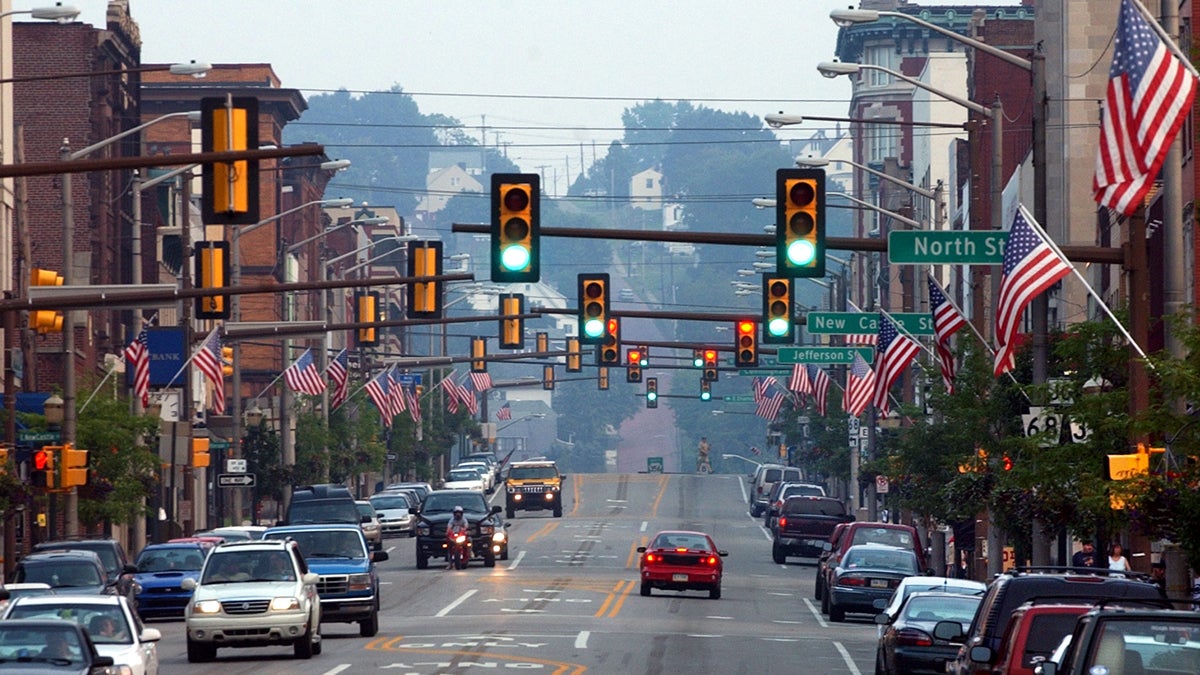Ideas Worth Stealing: Easing traffic with technology, not more blacktop

Traffic moves along the main street as signals change in Butler, Pa. (AP File Photo/Keith Srakocic)
Adaptive traffic signals that react to changing traffic patterns can ease commutes.
Ideas Worth Stealing: Every week, Keystone Crossroads will look to cities across the world for lessons in urbanism and municipal governance that could benefit Pennsylvania. No city does it all right, and we hope these examples from metropolises near and far inspire and encourage cities here to think outside the box.
Have you ever driven down a long boulevard, with traffic lights stacked like stepping stones to the horizon, and had to stop at every single one as it switched to red on your approach? Older traffic signals are programmed to hold a green or a red light according to average traffic patterns on a given road. Such plans are revised and adjusted every three to five years, but traffic patterns can change every few minutes.
As a result, traffic can become a nightmare and drivers waste money and time idling, businesses lose worker productivity due to delayed commutes, added emissions cause poorer air quality, and crashes go up.
According to the Texas A&M Transportation Institute, “travel delays due to traffic congestion caused drivers to waste more than 3 billion gallons of fuel and kept travelers stuck in their cars for nearly 7 billion extra hours – 42 hours per rush-hour commuter. The total nationwide price tag: $160 billion, or $960 per commuter.” In Philadelphia, that equated to 23 gallons of excess fuel consumed per commuter in 2014, 48 hours per commuter waiting in traffic, and $1,112 in congestion costs per commuter. In Pittsburgh, it was 21 excess gallons, 39 wasted hours, and $889 in congestion costs per commuter.
Now, cities (and states) are moving to more responsive systems in order to make commutes smoother.
Adaptive signals
In Bellevue, Washington, busy streets have been receiving a makeover, with older traffic lights making way for adaptive signals. The adaptive technology uses sensors to monitor, analyze, and adjust the length of time a light stays green or red in order to accommodate the most efficient flow of traffic. So if traffic starts to pile up on a specific roadway –- for example, due to regular rush hour build-up or an accident that causes detouring vehicles to clog a street –- sensors register the change and, using algorithms, the system immediately reprograms lights to stay green longer and keep traffic moving. As a result, drivers can ride a sort of green wave, as long as they’re following the speed limits the system is calculated to uphold.
Municipalities throughout Pennsylvania are seeing more and more adaptive signals replacing the more stagnant light systems, as well. Philadelphia recently centralized its traffic control operations, at least in part to take advantage of this technology. A centralized system makes it easier to coordinate changes in traffic light timing, since all signals are connected to the same system. In Pittsburgh, the city has worked with Carnegie Mellon University to install decentralized smart signals. There, adaptive traffic lights along specific corridors are just connected to each other, and automatic adjustments are made using software right at the lights.
Aleksandar Stevanovic, Director of the Lab for Adaptive Traffic Operations & Management, which studies adaptive technology, estimates that about three percent of all traffic signals in the U.S. have been replaced with adaptive lights.
Stevanovic said three factors make it hard to replace old lights faster.
One is budgets. Installing such signals can cost up to $50,000 per intersection, so change will only come as quickly as budgets allow.
Two is understanding and recruiting an adequate workforce to run the technology. “We’re moving to a more intelligent system, we need a more intelligent workforce,” he said. Though adaptive technology is automated, highly specialized engineers are necessary in the control center to tweak how the system reacts to changes in traffic patterns and to make sure that any signal timing adjustments are actually aligned with what the engineer is trying to accomplish on that stretch of road.
Three, said Stevanovic, is evaluating results. Are people idling less? Are drivers hitting fewer red lights? Basically: is it working? He said adaptive technology is “not a magic wand,” so it’s important to test progress and adjust accordingly. According to the Federal Highway Administration (FHWA), when adaptive systems are installed average travel times improve by more than 10 percent, and can improve by more than 50 percent when replacing particularly outdated traffic signal systems. Each municipality throws out its own numbers after the signals are installed, but Stevanovic said few of the studies are reliable and many of the reported improvements are “unrealistic.” He said well-executed studies can be time-consuming, but are crucial to any future expansion of adaptive technology.
If all this sounds very futuristic, traffic control systems are only going to get more and more responsive and personalized as connected vehicle technology grows. Imagine driving down that same boulevard mentioned above, where the lights kept turning red, but instead cruising along without stopping as your car tells you to either slow down or speed up to make a changing light. Or, imagine a street grid without any lights at all, one where stop and go signals appear on your own windshield as your car communicates with surrounding vehicles.
WHYY is your source for fact-based, in-depth journalism and information. As a nonprofit organization, we rely on financial support from readers like you. Please give today.


